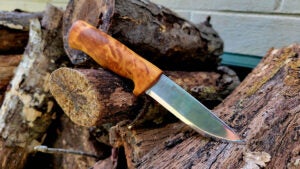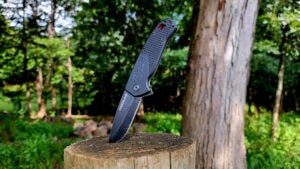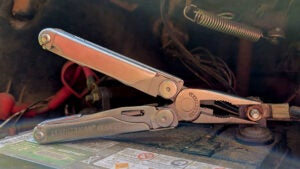I almost never walk out the door without a knife. Yeah, I might switch up which blade I take with me to feed the animals or tend to the yard or crops, but the bottom line, living on a farm, I’ve got this essential tool with me at all times.
While most people look for a knife only when they’re got cooking to do or are tearing into the latest Amazon delivery, farmers have a variety of reasons to carry a blade. Most commonly, we use them to open up a feed bag (even the stitched ones don’t always come apart the way they should) or to cut the twine or netting on a hay bale. Then again, we may also need them to remove a pesky splinter, detach a hungry tick, or cut some vegetables off the vine.
And the extreme cases? A good blade can be used for livestock castration or to harvest an animal at the end of their life. Back in 2019, a farmer even used a 3-inch blade to amputate his own leg after it got caught in some machinery.
Those may not be the first things that come to people’s minds, but that’s the reality of living on a farm and in isolated, rural areas.
And all of this applies no matter whether your farm is big or small, commercial or hobby, or focused on crops or livestock. I’ll ‘fess up to being a bit of a knife nut, especially because I also like be in the wilderness camping and hiking, so I’ve long been inquisitive about farmers’ knife selections and why they choose what they do.
Sometimes it’s purely about basic functions, sometimes it’s related to the type of steel, and other times its versatility. Essentially, there are three different styles of knives farmers gravitate toward: a fixed blade, a folder, and a bladed multitool. Here are the reasons for each:
Fixed blades
This is going to be your best workhorse knife. A fixed blade is built to take on the toughest tasks, especially if it has a full tang (meaning, the knife steel goes all the way through the handle to the butt). It can serve a multitude of uses, including cutting through thick hide and small bone. A fixed blade can even be used to chop down any saplings popping up near the pasture gate, and the spine has some creative applications when working on machinery.
This kind of knife is generally carried in a leather or nylon sheath on a farmer’s hip, making it safe and easily accessible.

Folding knives
This is a classic whenever someone think of a “pocket knife.” Folding knives can be safely tucked away into a pocket or a sheath, and when needed, unfolded and (usually) locked into place. Common types of locks are liner locks, frame locks, or button locks — all of which require an extra step to disengage the blade before folding it back into the handle.
Another style of folder is a slip-joint knife, but some people balk at the use of these knives, because they doesn’t “lock” the way other blades do — pressure applied in the wrong direction can cause the knife to fold in on itself (and onto your fingers). But if using a slip-joint knife properly and responsibly, with correct pressure causing the knife to stay open, then they are perfectly safe.
Folding knives tend to be more compact than their fixed-blade cousins, which is why they can be pocketed so simply and often carried discreetly.

Multitools
As the name suggest, multitools have more than just a basic blade on them — they have a bevy of functional tools that made them amazingly common around a farm. Most notably, multitools will feature a pair of pliers when unfolded, and usually there is some kind of screwdriver functionality, like the surprisingly robust center axis screwdriver on a standard bit that Gerber introduced a few years back.
And, of course, it doesn’t stop there. You can find multitools that have spring-loaded scissors, a can opener, a serrated saw, and a file.
When looking at multitools, farmers consider the number of features they have, so that they can complete their tasks properly. Farmers also look at the build quality and feel of the tool in their hand — after all, if someone has smaller hands, for example, some multitools may feel too big and unwieldy, especially if trying to use the needle-nose pliers on them.

Getting your hands on one
If you want a durable blade for some farm-like chores, we suggest:
- Fixed blade: Helle GT Outdoor Knife — The 9-inch drop-point blade carries over from the farm to the hiking path to the game trail with ease, making it a knife that’s hard to put down.
- Folding knife: Milwaukee Hardline Knife — Bump, bash, drop, or douse them, this knife has a tendency to laugh in the face of abuse.
- Multitool: Leatherman Wave — An iconic brand name, and the tool is pretty much perfect for the jack-of-all-trades that a farmer has to be.


